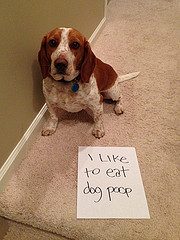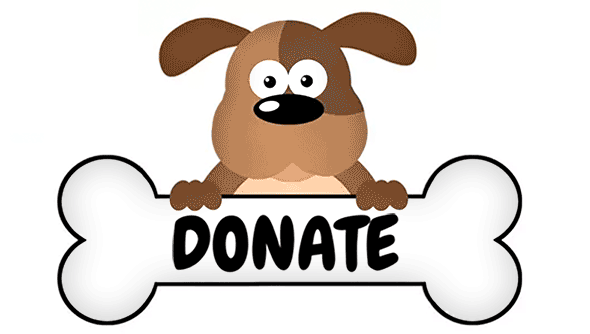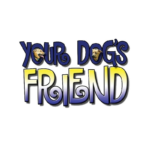
Photo by onionboy on Flickr
Eating Non-Food Items
When People Say, “UGH!!”, it is Probably Pica!
Puppies use their mouths to explore the world, chewing and swallowing things that were never meant to enter a dog’s digestive system. Fortunately, by around 6 months of age, most pups satisfy their curiosity without ingesting unsuitable things like socks, underwear, and plastic bags. Sometimes, however, the urge to eat non-food items can turn into a potentially life-threatening disorder known as pica.
Why Is My Dog Eating Crazy Stuff!?
- Boredom is a common cause of pica in puppies and young dogs.
- Dogs can learn that eating non-edibles can get them attention. Even a firm scolding can encourage bad behavior.
- Pica may be a symptom of a medical condition such as digestive disorder, parasites, a dietary imbalance, or poisoning. Ask your veterinarian to rule out any underlying medical cause for pica.
- Your dog’s diet may be deficient in some nutrient. Grass and soil can act as a dietary supplement and help improve a dog’s digestion. If your dog only “grazes” occasionally, this type of pica is not worrisome.
- If your dog can’t resist eating non-food items and would rather eat the inedible than do anything else, you might be dealing with a compulsion. In that case, find a professional experienced in treating compulsive pica. Treatment is often a combination of behavioral modification and drug therapy.
How to Discourage Pica in Puppies
- Mental stimulation and physical exercise will keep boredom—and pica—at bay. Provide a variety of safe toys and chews. Give your pup interactive toys that he has to push, tug, drop, or roll to get treats out. Play games, take walks, or set up playdates with compatible puppies. Look at our article on destructive chewing for a list of good chews and at our dog park handout for at-home activity ideas.
- Keep an eye on your pup. If you see him begin to pick up and mouth an inappropriate item, make a noise to distract him and then give him something better. If your pup wants you to chase him to get it, don’t take the bait. Pick up a toy or food that you know the pup will covet. Make a fuss over it and make sure your pup notices. If you are a good enough actor, he will start to lose interest in what he has and begin to follow you around. As soon as he drops the inappropriate item, give him the appropriate one. Immediately get the inappropriate one out of reach. Once you have redirected the pup’s attention to a safe toy or food, be lavish with your praise.
- Punishment is not the solution. If your dog expects punishment, he may only indulge in pica when you are not around and you may unknowingly trigger fear. Anxiety in turn may have the opposite effect and increase the risk of pica, as well as initiating resource guarding behavior.
Pica Problem Management
- Pica-proof your dog’s environment by making sure non-food items are nowhere around.
- If pica-proofing is unrealistic (for example, on walks around the neighborhood), accustom your dog to wearing a basket muzzle. For guidance, see the ASPCA article at https://www.aspca.org/pet-care/virtual-pet-behaviorist/dog-behavior/teaching-your-dog-wear-muzzle.
- Verbally discourage picking up a non-food item, with the “Leave It” cue, and have a favorite toy or special food available that you can trade if your dog will not easily give up the inedible. Remember that what you trade has to be more valuable to your dog than the inedible item he already has. Praise your dog for making the right choice.
- You can distract your dog, while also making your walks more fun. Run, walk, pivot, chase, practice training, play with a toy, weave around trees.… Fun activities and being unpredictable on walks will keep your dog focused on you, instead of the ground.
- Some dogs will carry a ball or toy in their mouths on walks. They can’t hold something and pick up something new at the same time.
Trained Behaviors That Thwart Pica
- Recall: If you have a reliable recall, you can use it to call your dog away from a tempting non-edible.
- Put an incompatible behavior like sit or bark on cue: If your dog is barking, he can’t be swallowing.
- “Go get your toy” is another incompatible behavior. Holding a toy in his mouth can prevent toy-loving dogs from picking up stuff on the ground.
- Targeting. If your dog is touching his nose to your hand he is not picking up foreign objects.
- Leave It. Teach him not to go near an object without permission.
- Drop It. If he grabs a verboten object, teach him to spit it out on command.
Teaching Your Dog to Leave It and Drop It
Teaching dogs how to stay away from or drop things may someday save your dog’s life. So, here are links to help you teach your dog these skills. They are from trainer Laurie Luck in her Smart Dog University blog.
Leave It
http://smartdoguniversity.com/7-easy-steps-to-teach-your-dog-leave-it/
Drop It
http://smartdoguniversity.com/?s=giving+up+stuff
Laurie breaks down these skills into very simple steps. However, you need to practice at home before using “Leave It” or “Drop It” out in the real world, when you absolutely need your dog to comply. Any unusual noise can interrupt your dog, but take the time to teach your dog what you want him to do. It will be easier for both of you.
Key Points to Remember
• Pica, a term for regularly eating non-food items, can be caused by a medical condition, diet, attention seeking, boredom, or a compulsive disorder.
• Physical exercise, mental stimulation, and fun, unpredictable walks can help prevent PICA caused by boredom.
• Train skills, like “Leave It” and “Drop It”, to prevent your dog from ingesting dangerous items.
• In your home, put away non-food items that your dog is attracted to.
Resources
VCA Animal Hospitals article on stool eating, Coprophagia in Dogs.
PetMd.com, Ingestion of Feces and Foreign Objects in Dogs, video and article.
Still Need Help?
Contact Your Dog’s Friend at [email protected] or (301)983-5913 for advice and referrals or check out our list of recommended trainers and behaviorists.
Your Dog’s Friend is a nonprofit 501(c)(3) organization working to improve dogs’ lives, reduce problem behaviors, and keep dogs out of shelters, by educating and supporting their humans.
This material is not intended to be a substitute for professional help when dealing with dogs with intense or potentially dangerous behavior issues. Consult a positive reinforcement trainer or veterinary behaviorist for professional assessment, guidance, and support.




